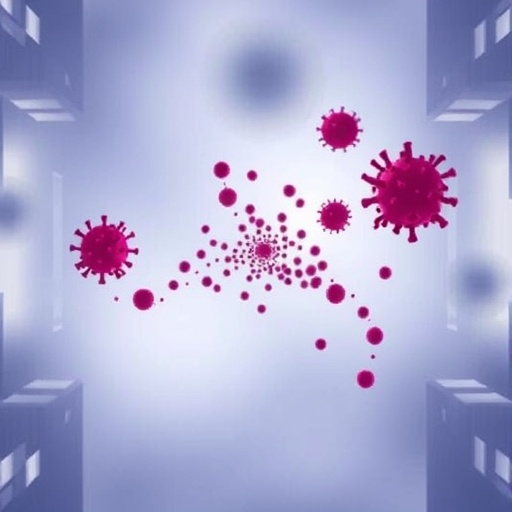In a groundbreaking study published in the latest issue of npj Viruses, researchers have unveiled new insights into the survival dynamics and transmission fitness of SARS-CoV-2 particles suspended in aerosols. As the world continues to grapple with COVID-19 variants and their modes of contagion, this study offers a nuanced understanding of the virus’s endurance and infectivity during airborne transmission—a key factor in shaping public health strategies for pandemic control.
The research, conducted by Zhang, Donovan, Weninger, and their colleagues, utilized a sophisticated aerosolization chamber to investigate how SARS-CoV-2 behaves over time when suspended in airborne droplets. Unlike previous studies that primarily focused on environmental persistence on surfaces or in static air environments, this work meticulously quantified the virus’s stability during “time-of-flight” in dynamically generated aerosols, simulating real-world respiratory emissions more accurately.
Central to their methodology was the aerosolization chamber, a controlled environment designed to replicate the conditions of viral particles emitted from an infected host during coughing, speaking, or breathing. By precisely measuring viral titers at different time intervals as the particles traveled through the chamber, the researchers were able to map the decay curve of infectivity and assess how transmission fitness—essentially the virus’s ability to establish infection—was impacted by airborne residence time.
.adsslot_RvbMZAWhay{ width:728px !important; height:90px !important; }
@media (max-width:1199px) { .adsslot_RvbMZAWhay{ width:468px !important; height:60px !important; } }
@media (max-width:767px) { .adsslot_RvbMZAWhay{ width:320px !important; height:50px !important; } }
ADVERTISEMENT
The findings reveal a complex interplay between viral particle integrity and environmental factors, highlighting that SARS-CoV-2 retains a significant proportion of its infectious potential even after prolonged time-of-flight in aerosolized form. Contrary to some earlier assumptions that the virus degrades rapidly once airborne, the study demonstrates that a non-negligible fraction of virions remains capable of initiating infection well beyond immediate emission events, reinforcing airborne transmission as a critical route.
Of particular interest is the observation that the virus’s survival does not follow a simple exponential decay but rather exhibits a biphasic pattern influenced by droplet size distribution, humidity, and aerosol physicochemical properties. These elements dictate the microenvironment surrounding each viral particle, affecting viral envelope integrity and RNA stability during suspension in air, thereby modulating transmission fitness dynamically.
Insights gained from this study could recalibrate risk assessments related to indoor air quality, especially in high-occupancy spaces where aerosol accumulation and movement patterns are complex. Improved understanding of viral persistence over time-of-flight underscores the importance of ventilation strategies and air filtration technologies that reduce aerosol residence times, ultimately diminishing transmission risk.
The approach also allowed researchers to dissect the nuanced relationship between viral load in expelled droplets and their infectious lifespans, revealing that smaller aerosols—less than 5 micrometers—serve as more stable vehicles for SARS-CoV-2 transmission over time and distance. These findings corroborate epidemiological data suggesting that airborne particles of this size enable long-range transmission beyond close contact.
Furthermore, the study probes the physicochemical stressors encountered by SARS-CoV-2 during aerosolization, such as shear forces and desiccation. Understanding how these factors impair or preserve viral infectivity is paramount for designing interventions that disrupt airborne spread, including mask efficacy and environmental modifications.
In addition, the research team applied state-of-the-art virological assays and molecular quantification techniques, ensuring that measured declines in infectivity were not simply due to detection limits but reflected true viral degradation processes. This rigor enhances confidence in the conclusions drawn about SARS-CoV-2’s aerosol stability and transmission potential.
Although environmental variables such as temperature and relative humidity were tightly controlled, the study acknowledges the need for further exploration under diverse climatic conditions to simulate real-world heterogeneity. Nonetheless, the foundational data presented establishes a critical benchmark for modeling the airborne phase of SARS-CoV-2 transmission.
The implications of these findings extend beyond SARS-CoV-2, providing a framework for evaluating other respiratory viruses with pandemic potential. By delineating how viruses survive and transmit during aerosolized time-of-flight, this approach can inform preparedness efforts for future airborne pathogens.
In summary, this meticulous investigation into SARS-CoV-2’s survival and transmission fitness during aerosol time-of-flight elucidates fundamental viral characteristics that underlie airborne contagion. It advances the scientific community’s capacity to characterize transmission dynamics with precision, ultimately informing public health policies aimed at mitigating viral spread in indoor environments.
As the pandemic evolves and novel variants emerge, the insights from this research hold promise for optimizing non-pharmaceutical interventions and enhancing airborne risk mitigation strategies. They highlight the criticality of aerosol science in pandemic response and underscore that airborne transmission remains a dominant and actionable pathway for SARS-CoV-2 dissemination.
This study marks a pivotal contribution to virology and public health, illuminating how time spent airborne shapes SARS-CoV-2’s infectious trajectory. Its integration of aerosol physics and viral infectivity assays sets a new standard in the field, bridging microbiology and airborne pathogen transmission research.
In a world still grappling with COVID-19’s shifting landscape, this research delivers actionable intelligence on a microscopic yet mighty adversary’s airborne lifespan. It challenges simplistic views and calls for a sophisticated appreciation of viral transmission mechanics, raising awareness about the subtleties governing infection spread.
Ultimately, Zhang and colleagues’ work advances our understanding of SARS-CoV-2 transmission climates, equipping scientists, policymakers, and the public alike with vital information to confront ongoing and future respiratory virus outbreaks with enhanced precision and efficacy.
Subject of Research: Survival and transmission fitness of SARS-CoV-2 in aerosolized form during airborne time-of-flight.
Article Title: Survival and transmission fitness of SARS-CoV-2 over the time-of-flight in an aerosolization chamber.
Article References:
Zhang, Y., Donovan, J.M., Weninger, D.W. et al. Survival and transmission fitness of SARS-CoV-2 over the time-of-flight in an aerosolization chamber.
npj Viruses 3, 61 (2025). https://doi.org/10.1038/s44298-025-00143-8
Image Credits: AI Generated
Tags: aerosolization chamber researchCOVID-19 airborne contagion studydecay curve of SARS-CoV-2 infectivityenvironmental persistence of viruses in airimpact of aerosols on pandemic controlpublic health strategies for COVID-19real-world modeling of virus spreadSARS-CoV-2 aerosol transmissionSARS-CoV-2 endurance in respiratory emissionstransmission fitness of respiratory virusesviral infectivity in airborne dropletsvirus survival dynamics in aerosols





